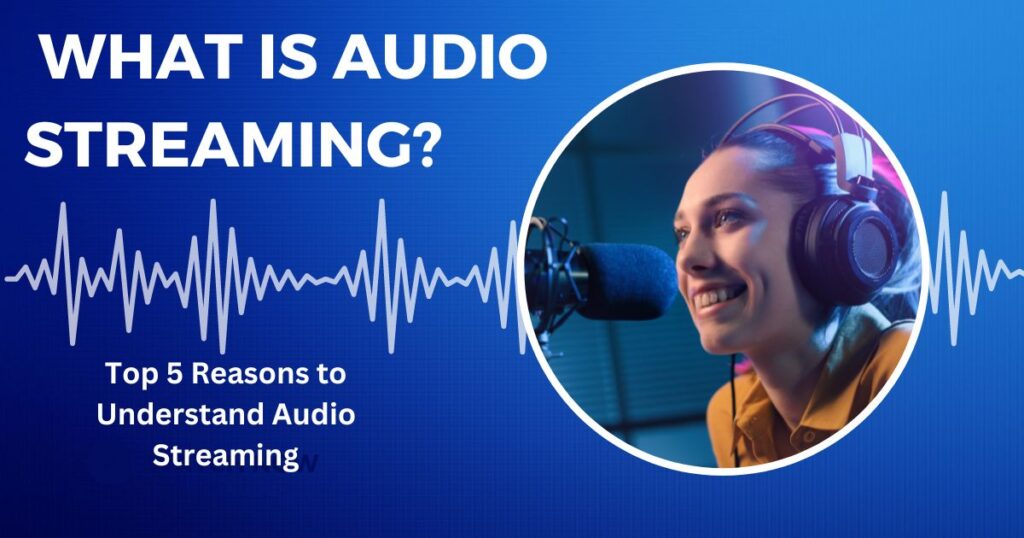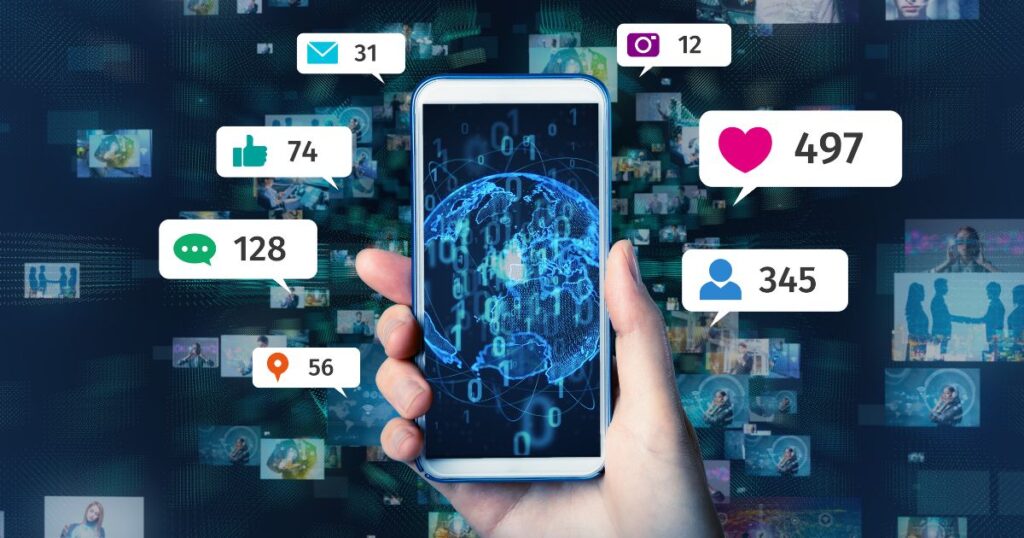What is Audio Streaming?

In today’s digital age, we’re constantly bombarded with new terms and technologies. One that’s taken the world by storm is audio streaming. But what exactly is it? Well, picture this: you’re lounging on your couch, craving your favorite tunes or that gripping podcast you’ve been hooked on. Instead of rummaging through CDs or downloading files, you simply tap an app, and voilà! The music, or podcast, starts playing instantly. That, my friend, is the magic of audio streaming.
Audio streaming is the process of transmitting audio content over the internet in real-time. It’s like having a never-ending jukebox at your fingertips, playing music, podcasts, audiobooks, and more without needing to store them on your device. The beauty of it? You can enjoy high-quality audio without eating up your precious storage space.
The Rise of Audio Streaming
Remember the days of Napster and LimeWire? Those were the wild west days of digital music. Fast forward to today, and we’ve got sleek platforms like Spotify, Apple Music, and Pandora dominating the scene. The shift has been monumental. In fact, the Recording Industry Association of America (RIAA) reported that in 2022, streaming accounted for a whopping 84% of total music industry revenues in the U.S.
| Year | Streaming Revenue Share |
|---|---|
| 2015 | 34% |
| 2018 | 75% |
| 2022 | 84% |
Source: RIAA Year-End 2022 Revenue Report
Why the surge? Well, it’s a perfect storm of faster internet speeds, smart devices everywhere, and our insatiable appetite for on-demand content. We want what we want when we want it, and audio streaming delivers just that.
Why Should You Care About Audio Streaming?
Now, you might be thinking, “That’s neat, but why should I care?” Great question! Understanding audio streaming isn’t just about being tech-savvy; it’s about enhancing your daily life. Let’s dive into the top 5 reasons why getting the lowdown on audio streaming is a game-changer.
1. Unparalleled Convenience
First things first, convenience is king. Gone are the days of lugging around CDs or filling up your phone with MP3s. With audio streaming, your entire music library, favorite podcasts, and audiobooks are just a tap away. Heading to the gym? Your workout playlist is ready. Long commute? Catch up on that true crime podcast. It’s like having a personal DJ and storyteller in your pocket, 24/7.
How Streaming Simplifies Your Life
- No Physical Storage: No more shelves of CDs or gigabytes of files clogging your devices.
- Cross-Device Sync: Start a podcast on your phone, continue on your laptop, finish on your smart speaker.
- Curated Playlists: Platforms create personalized playlists based on your mood, activity, or taste.
2. Discover New Content Effortlessly
Remember flipping through radio stations, hoping to catch a good song? Those days are over. Audio streaming platforms use smart algorithms to understand your taste and introduce you to new artists, genres, and podcasts you’ll love.
Personalized Discovery
- Algorithmic Magic: The more you listen, the better the platform understands your preferences.
- Genre Exploration: Easily jump from jazz to K-pop to classical, expanding your audio horizons.
- Community Curated: Follow friends, influencers, or artists to see what they’re into.
| Discovery Feature | How It Helps |
|---|---|
| Personalized Daily Mixes | Blend of favorites and new tracks tailored for you |
| Genre-based Radio | Endless stream of songs in a chosen genre |
| “Fans Also Like” Section | Find similar artists based on listener habits |
3. Cost-Effective Entertainment
Let’s talk money. Back in the day, building a decent music collection meant shelling out big bucks. A single album could set you back $15-$20. Now, for about the price of one CD a month, you get access to millions of songs and countless hours of podcasts.
The Economics of Streaming
- Subscription Models: Pay once, stream unlimited content all month.
- Free Tiers: Many platforms offer ad-supported free versions.
- Family Plans: Share the cost (and playlists) with your whole crew.
4. Support Artists and Creators

You might’ve heard that streaming doesn’t pay artists well. While there’s ongoing debate about royalties, streaming has opened up new avenues for artists to reach global audiences and for podcast creators to monetize their content.
How Streaming Helps Creators
- Global Reach: An indie band in Seattle can find fans in Sydney overnight.
- Data Insights: Artists see where their fans are, helping plan tours and releases.
- Podcast Boom: Streamers like Spotify are investing heavily in podcasts, creating new opportunities.
5. Offline Listening and High-Quality Audio
But wait, there’s more! Most streaming services now offer offline listening. Going on a flight or into the subway? Download your content beforehand and enjoy uninterrupted playback. And for audiophiles, many platforms provide high-fidelity options that rival or exceed CD quality.
Audio Streaming Perks
- Offline Mode: Download content for playback without an internet connection.
- Hi-Fi Options: Platforms like Tidal and Amazon Music HD offer lossless audio.
- Automatic Quality Adjustment: Saves data by adjusting quality based on your connection.
How Does Audio Streaming Actually Work?
Alright, let’s geek out a bit. Understanding the basics of how audio streaming works can help you troubleshoot issues and appreciate the technology even more.
The Magic Behind the Music
At its core, audio streaming involves breaking down an audio file into small packets of data. These packets are sent over the internet to your device, which reassembles them in real-time. It’s like getting pieces of a puzzle one by one and putting them together as they arrive, creating a seamless audio experience.
Key Components
- Compression: Audio files are compressed to reduce size without drastically impacting quality.
- Buffering: A small portion of the audio is downloaded ahead of time to prevent interruptions.
- Adaptive Bitrate: The quality adjusts based on your internet speed to maintain playback.
Streaming vs. Downloading
Now, you might wonder, “How’s this different from just downloading a file?” Great question! When you download, you get the entire file before you can use it. With streaming, you can start listening almost immediately because you only need a small part of the file to begin playback.
| Feature | Streaming | Downloading |
|---|---|---|
| Start Time | Near-instant | After full file download |
| Storage Required | Minimal (cache) | Full file size |
| Internet Dependency | Continuous (or offline mode) | Only for download |
| File Ownership | Access-based | File on device |
The Future of Audio Streaming
Whew! We’ve covered a lot of ground. But what’s on the horizon for audio streaming? Hold onto your headphones, because it’s looking pretty exciting.
AI and Personalization

Artificial Intelligence is getting smarter by the day. Expect your streaming services to offer hyper-personalized playlists that not only match your taste but also your current mood, weather, or even your heart rate during workouts.
Voice-Controlled Streaming
With the rise of smart speakers like Amazon Echo and Google Home, voice-controlled streaming is becoming the norm. “Alexa, play something upbeat!” and bam, your living room’s a dance party.
Augmented Audio Experiences
Imagine listening to a true crime podcast and hearing 3D sound effects that make you feel like you’re at the scene. Or how about real-time translations for international podcasts? The line between audio and immersive experiences is blurring.
Social Streaming

Platforms are increasingly adding social features. Soon, you might be able to host virtual listening parties, collaborate on playlists with friends across the globe, or even attend live-streamed concerts with interactive elements.
Conclusion: The Sound of the Future is Streaming
And there you have it, folks! We’ve journeyed through the what, why, and how of audio streaming. From its humble beginnings to its tech-driven future, audio streaming is more than just a convenience—it’s a revolution in how we consume and interact with audio content.
To recap our top 5 reasons to understand audio streaming:
- Unparalleled Convenience: Your entire audio world, one tap away.
- Effortless Discovery: New favorites found through smart algorithms.
- Cost-Effective Entertainment: Millions of songs for the price of one CD.
- Support for Creators: A global stage for artists and podcasters.
- Offline and Hi-Fi Listening: Quality tunes, with or without Wi-Fi.
Understanding audio streaming means you’re not just a passive listener; you’re an active participant in a global audio community. You’re supporting artists, discovering new voices, and doing it all with incredible ease and quality.
As we look to the future, audio streaming is only going to get smarter, more personalized, and more immersive. By getting on board now, you’re not just keeping up; you’re staying ahead of the curve.
So, the next time you’re lost in your favorite album or gripped by a podcast cliffhanger, take a moment to appreciate the incredible technology that’s bringing that experience to your ears. Audio streaming isn’t just changing how we listen; it’s changing how we live, one stream at a time.
Now, go forth and stream! Your next favorite song, podcast, or audiobook is just waiting to be discovered. Happy listening! 🎶🎧
FAQ: Your Audio Streaming Questions Answered
1. Is audio streaming better than owning music files?
It depends on your needs. Streaming offers vast libraries and convenience without storage concerns. However, owning files means you always have access, even without internet. Many music lovers now do both: stream for discovery and buy their absolute favorites.
2. How much data does audio streaming use?
On average, streaming music uses about 40–80 MB per hour at normal quality, or up to 350 MB for high-quality. Most platforms let you adjust quality to save data. Also, remember that offline downloads use data only once, saving you in the long run.
3. Can I use the same streaming account on multiple devices?
Absolutely! Most services allow you to use one account on several devices. However, simultaneous streaming (playing on multiple devices at once) might be limited or require a premium plan.
4. Are there any audio streaming services for audiobooks?
Yes! While Audible (owned by Amazon) is the giant in this space, other services like Scribd, Apple Books, and even some music streamers like Spotify are expanding into audiobooks. They often offer subscription models similar to music streaming.
5. Is audio streaming safe and legal?
When you use official apps like Spotify, Apple Music, or Pandora, it’s completely legal. They handle royalties and licensing. As for safety, stick to reputable services and use strong, unique passwords. Most platforms also offer two-factor authentication for extra security.
The Evolution of Audio Streaming: From Niche to Mainstream
We’ve covered the what, why, and how of audio streaming, but let’s take a moment to appreciate how far we’ve come. It’s a classic tale of tech evolution, from a niche hobby for early adopters to a global phenomenon that’s reshaping industries.
The Early Days: Buffering and Bit Rates
Cast your mind back to the late 90s and early 2000s. Internet speeds were… well, let’s just say “glacial” would be a compliment. Audio streaming was a test of patience. You’d click play, wait for the buffering (remember that spinning wheel?), get a few seconds of music, then back to buffering. It was like trying to enjoy a song through a bad phone connection.
The Pioneers
- RealAudio was one of the first to offer streaming audio in 1995.
- Winamp is not just a player; it integrates online radio streams.
- Last.fm: Launched in 2002, it was early to the personalized radio game.
The Spotify Revolution
Fast forward to 2008. A little Swedish startup called Spotify launches in Europe. Their pitch? “All the world’s music, all for free.” It was a game-changer. Suddenly, you had millions of songs at your fingertips, with a sleek interface and (gasp!) no buffering.
What Spotify Got Right
- Freemium Model: Free tier with ads, premium for no ads and more features.
- Social Integration: Share and discover through Facebook friends.
- Emphasis on Playlists: From algorithmically generated to user-curated.
| Year | Spotify Milestones |
|---|---|
| 2008 | Launch in Sweden |
| 2011 | U.S. launch, integration with Facebook |
| 2015 | Video content and podcasts added |
| 2020 | Over 320 million active users worldwide |
The Podcast Boom
While music was streaming’s first love, podcasts have become its passionate affair. Once a niche medium, podcasts have exploded in popularity. Why? They fit perfectly into our multitasking lives. Commuting, working out, doing chores – podcasts make it all more engaging.
Audio Streaming’s Role in Podcasting
- Discoverability: Algorithms help surface new podcasts based on your interests.
- Binge-Listening: Like Netflix for your ears. Entire seasons available at once.
- Integration: Many music streaming apps now prominently feature podcasts.
According to Edison Research, in 2023, over 60% of Americans 12+ have listened to a podcast. That’s up from just 11% in 2006. Audio streaming platforms have been key drivers of this growth.
The Tech Behind the Tunes: A Deeper Dive
Now that we’ve seen how audio streaming grew up, let’s geek out a bit more on the tech that makes it all possible. Don’t worry; we’ll keep it simple and fun!
Codecs: The Compression Champs
Ever wondered how a four-minute song that’d take up 40MB as an uncompressed WAV file streams to you using just a fraction of that data? Enter codecs, the unsung heroes of audio streaming.
Popular Codecs
- MP3: The old reliable. Good compression, widely supported.
- AAC: Apple’s go-to. Better quality than MP3 at the same bit rate.
- Opus: The new kid. Open-source, low latency, great for live streaming.
Think of codecs like packing wizards. They look at an audio file, figure out what parts the human ear is less sensitive to, and then compress those parts more heavily. It’s like they’re saying, “You won’t miss this tiny detail, so let’s save some space!”
Cloud vs. P2P: How the Music Gets to You
There are two main ways streaming services deliver audio to your ears:
- Cloud Streaming: This is the most common. Services like Spotify and Apple Music store songs on huge server farms. When you hit play, it zips from their server to your device. It’s reliable but can strain servers during peak times.
- Peer-to-Peer (P2P): Here’s where it gets interesting. Some services, like the early days of Spotify, used P2P. It’s like a musical potluck. You bring a dish (songs you’ve downloaded), I bring one, and we all share. It reduces load on central servers but raises privacy concerns.
| Method | Pros | Cons |
|---|---|---|
| Cloud Streaming | Reliable, scalable, more control | Server costs, potential bottlenecks |
| P2P | Reduces server load, can be faster | Privacy issues, depends on user base |
AI in Audio: More Than Just Recommendations
We touched on AI earlier, but it’s doing way more than just curating your “Discover Weekly.” It’s like having a super-smart audio engineer and producer rolled into one.
AI Audio Tricks
- Auto-Mastering: Services like LANDR use AI to master tracks, making indie artists sound pro.
- Noise Reduction: Ever listened to a podcast recorded in someone’s noisy apartment? AI can now filter that out.
- Voice Cloning: Some apps can mimic voices. Imagine an audiobook in your favorite actor’s voice!
The Dark Side of the Stream: Challenges and Controversies
It’s not all smooth listening in the world of audio streaming. Like any disruptive tech, it’s faced its share of static.
Artist Compensation: A Sour Note
One of the loudest criticisms is how little artists earn per stream. On Spotify, it’s estimated that artists earn between $0.003 and $0.005 per stream. Do the math: an artist might need over 250,000 streams to earn $1,000.
The Debate
- Streaming Services: “We’re growing the pie. More listeners mean more revenue overall.”
- Artists: “But we’re getting crumbs of that pie. It’s not sustainable.”
This has led to some high-profile boycotts and the rise of artist-friendly platforms like Bandcamp.
Privacy Concerns: Who’s Listening to You Listen?
Remember how we said streaming services get to know your tastes? Well, that data is valuable. It’s used for ads, marketing, and more. Some users are uneasy about how much these platforms know about their moods, routines, and relationships based on listening habits.
Notable Incidents
- In 2020, Spotify patented tech to analyze users’ voice and background noise to recommend music.
- Some smart speakers have been caught recording when they shouldn’t, raising alarm bells.
The Paradox of Choice: Too Much of a Good Thing?
With millions of songs and podcasts at our fingertips, you’d think we’d be in audio heaven. But there’s a phenomenon called “choice paralysis.” When faced with too many options, we can feel overwhelmed and end up sticking to what we know.
It’s like standing in a massive ice cream shop with 1000 flavors. Sounds amazing, but you might just end up with vanilla because deciding is too hard!
The Future is Loud: What’s Next in Audio Streaming?
We’ve journeyed from the crackly days of RealAudio to the AI-powered streaming of today. But the audio adventure is far from over. Let’s put on our futurist headphones and listen to what’s coming.
Spatial Audio: 3D Sound for Your Ears
Imagine listening to a concert where you can “move” through the crowd, hearing different instruments more clearly as you get closer to them. That’s spatial audio. It uses advanced processing to create a 3D soundscape.
- Gaming: Footsteps behind you in a shooter? You’ll know exactly where.
- Virtual Concerts: Feel like you’re on stage with your favorite band.
- Immersive Podcasts: True crime shows where you hear the “crime scene” in 360 degrees.
AI-Generated Content: The Ultimate Personalization
We’ve seen AI recommendations, but what about AI-created content? It’s already happening:
- Personalized Soundtracks: AI composing music that changes based on your heart rate during workouts.
- AI Radio Hosts: Smoothly introducing songs and adapting to breaking news.
- Customized Bedtime Stories: Kids’ audiobooks that feature them as the main character.
Blockchain and NFTs: Owning a Piece of the Stream
Blockchain tech, famous for cryptocurrencies, is making waves in audio. Non-Fungible Tokens (NFTs) could let fans own unique digital assets:
- Exclusive Tracks: Buy the only copy of your favorite artist’s unreleased song.
- Smart Royalties: Artists could get paid instantly and transparently every time their song streams.
- Fan Investments: Support an upcoming artist by buying a share in their next album’s earnings.
Streaming Beyond Music: The Audio-verse Expands
Audio streaming won’t just be about music and podcasts. It’s becoming the delivery method for all things audio:
- Audio-First Social Networks: Imagine Twitter, but with voice messages instead of tweets.
- Live Audio Events: Conference talks, Q&As, even city council meetings, all streamed.
- Educational Audio: From language lessons to university lectures, all are optimized for audio learning.
In Conclusion: The Sound of Progress
Phew! We’ve covered a lot of ground, from the stuttering streams of the 90s to the AI-composed soundtracks of tomorrow. Audio streaming isn’t just a technology; it’s a journey that mirrors our growing desire for personalized, on-demand content that fits seamlessly into our lives.
To recap our whirlwind tour:
- We started with understanding what audio streaming is – your personal, infinite jukebox.
- We dove into the top 5 reasons it matters, from convenience to artist support.
- We geeked out on how it works, with codecs compressing tunes and AI curating your next favorite track.
- We faced the music on challenges like fair artist pay and privacy concerns.
- Finally, we put on our futurist headphones to hear spatial audio, blockchain royalties, and AI-generated content.
Throughout this journey, one thing is clear: audio streaming is more than just a way to listen. It’s a technology that’s deeply personal, constantly evolving, and increasingly woven into the fabric of our daily lives.
As we look (and listen) to the future, it’s exciting to think that the next big leap in audio streaming might be just around the corner. Maybe it’ll be beaming podcasts directly to brain implants (yep, that’s a real thing being worked on!), or AI that can remix your favorite album to perfectly match your current mood.
Whatever comes next, one thing’s for sure: the world of audio streaming will keep spinning, keep innovating, and keep finding new ways to fill our lives with sound. So keep your ears open, your playlists fresh, and your mind curious.
After all, in the grand symphony of technology, audio streaming is still just warming up. The best tracks are yet to come. 🎶🚀🎧



